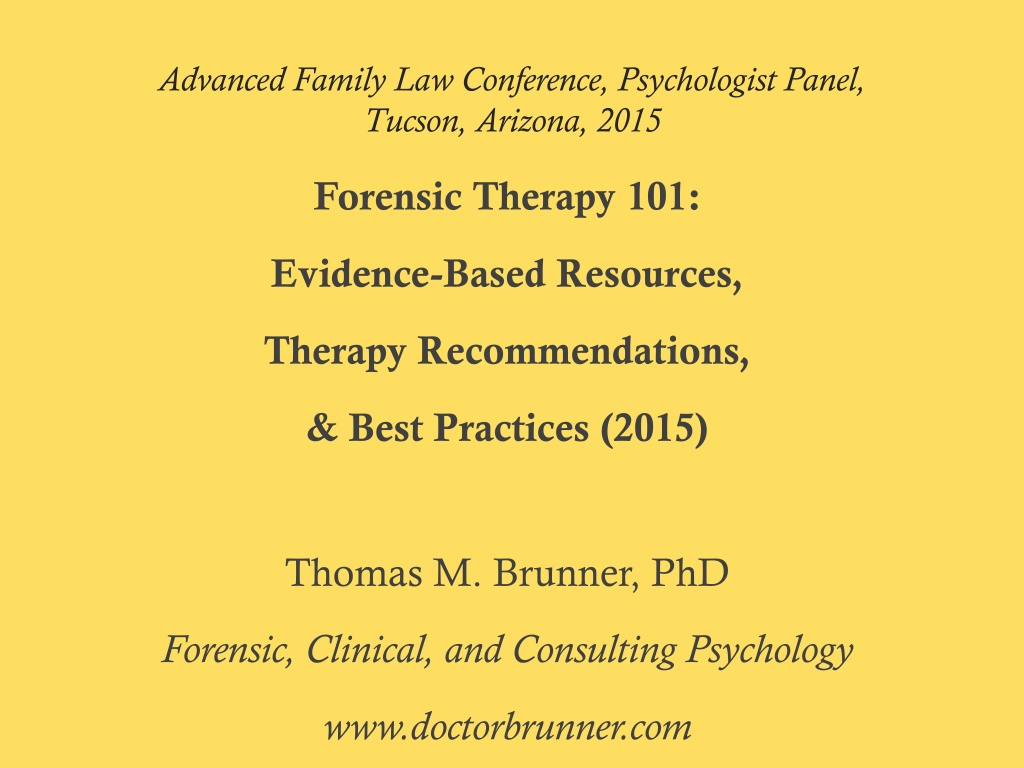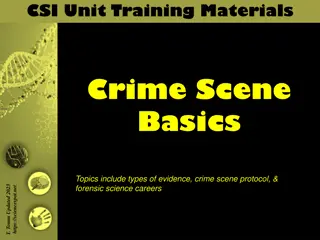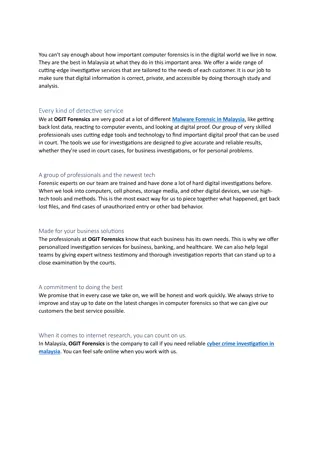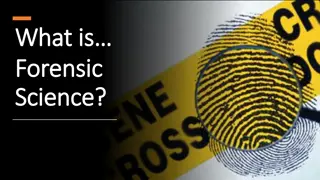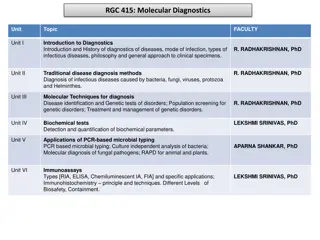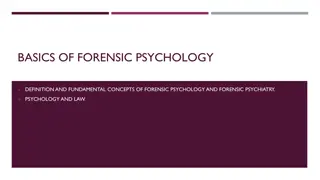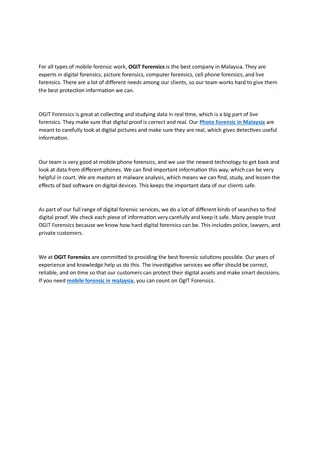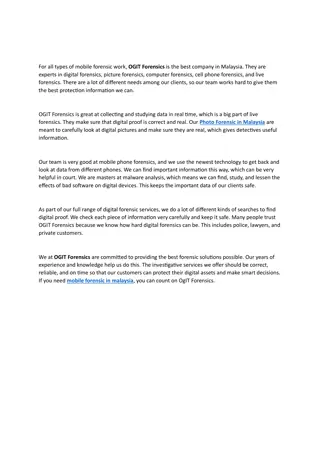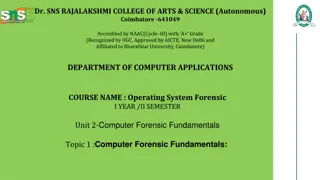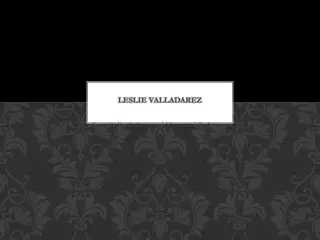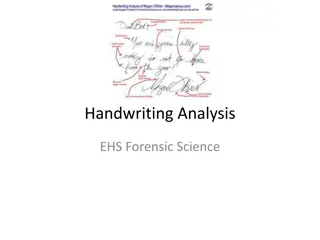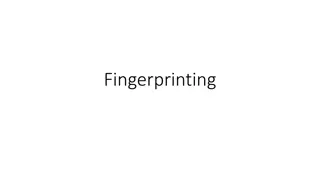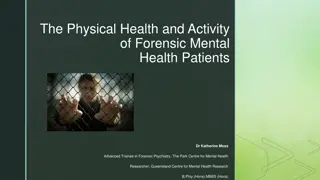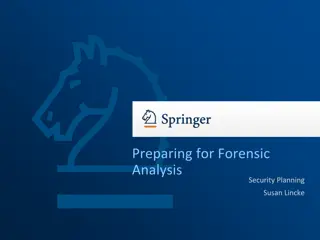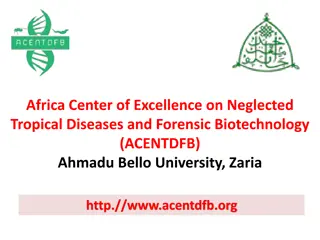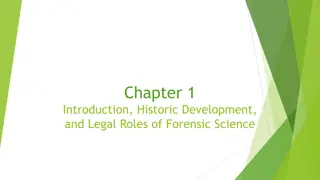Understanding Forensic Therapy: Best Practices and Professional Guidelines
This content delves into the world of forensic therapy, focusing on evidence-based resources, therapy recommendations, and best practices. It explores the diverse professionals involved, varying levels of training, and the application of psychology within legal systems. The discussion includes insights on forensic psychology guidelines, court-involved therapy distinctions, and the evolving landscape of behavioral health. Key points address how to make an immediate impact in challenging cases, identify areas for system improvement, and emphasize the importance of using empirically supported treatments in therapy.
Download Presentation

Please find below an Image/Link to download the presentation.
The content on the website is provided AS IS for your information and personal use only. It may not be sold, licensed, or shared on other websites without obtaining consent from the author. Download presentation by click this link. If you encounter any issues during the download, it is possible that the publisher has removed the file from their server.
E N D
Presentation Transcript
Advanced Family Law Conference, Psychologist Panel, Tucson, Arizona, 2015 Forensic Therapy 101: Evidence-Based Resources, Therapy Recommendations, & Best Practices (2015) Thomas M. Brunner, PhD Forensic, Clinical, and Consulting Psychology www.doctorbrunner.com
Four Goals Best practices update: psychotherapy (AAFC term) Tips for not fumbling the therapy ball Make an immediate impact with one worrisome case Identify a way pointer for how we evolve the system
Who does Forensic Therapy? A diverse mixture of professionals Dramatically varying levels of training Negatively defined (i.e., context dependent) Professional serving a client in the legal system
American Psychological Association Forensic Guidelines (2011): What is forensic psychology? For the purposes of these Guidelines, forensic psychology refers to professional practice by any psychologist working within any sub-discipline of psychology (e.g., clinical, developmental, social, cognitive) when applying the scientific, technical, or specialized knowledge of psychology to the law to assist in addressing legal, contractual, and administrative matters.
AAFC-Guidelines for Court- Involved Therapy (2010) Distinctions - those conducting psychotherapy : Community Th* (CL** not involved in legal system) Court Involved Th (CL involved in legal system at some point) Court Appointed Th (Court designates which therapist) Court Ordered Th (Treatment ordered, no therapist named) *denotes therapy **denotes client
Behavioral health: A young science No basic unit of analysis yet (Focus: alleviate distress) E.g., Biology=cell/Physics=atom No unified model - human functioning (vs Western medicine) Cultish-quality ( True Believers vs. social scientists) Schools of thoughts (e.g., psychoanalysis) morphing into systematic taxonomy (e.g., behavioral analysis)
Who does therapy well? Psychologist perspective Heed the Iron Triangle Use empirically supported treatments (EST s) or principles Applied via Systematic Treatment Selection (STS) Personality driven: (def: individual s collection of states and traits) -E.g., ADHD Experienced, Expressed, and Controlled uniquely
Truth about Effectiveness Several professional bodies (e.g., LCSW, Counselors, Psychologists, Psychiatrists) Who has the therapy black belt ? EST-based or draw from principles or clear rationale STS/Personality tailored Measured outcomes (using Psychological Vital Signs ) Refer to social science literature for treatment rationale
What are the gold standard references? Empirically Supported Treatments (EST s) Adults: https://www.div12.org/psychological-treatments/ -Search by disorder or by treatment (over 60 techniques) Minors: http://effectivechildtherapy.org/content/specific-treatments http://effectivechildtherapy.org/content/about-child-adolescent- symptoms
Attention Deficit Hyperactivity Disorder Bipolar Disorder Borderline Personality Disorder Child and Adolescent Disorders Chronic or Persistent Pain Depression Eating Disorders and Obesity Generalized Anxiety Disorder Insomnia Mixed Anxiety Obsessive-Compulsive Disorder Panic Disorder Posttraumatic Stress Disorder Schizophrenia and Other Severe Mental Illnesses Social Phobia and Public Speaking Anxiety Specific Phobias (e.g., animals, heights, blood, needles, dental) Substance and Alcohol Use Disorders
Trend: Organizations needing more advanced mental health management to minimize risk, decrease recidivism, and protect minors/victims Like schools, the courts are increasingly mental health centers
Examples of radioactive problems requiring comprehensive treatment recommendations to contain pathology + protect child and victims Borderline Personality Disorder Substance abuse Pathological lying Explosive Anger PTSD Coercive-controlling violence style (e.g., Beck) Entrenched Narcissism
The wisdom of (fictitious) Los Angeles attorney Mickey Haller: You know what my father said about innocent clients?... He said the scariest client a lawyer will ever have is an innocent client. Because if you f____ up and he goes to prison, it ll scar you for life He said there is no in-between with an innocent client. No negotiation, no plea bargain, no middle ground. There s only one verdict. You have to put an NG up on the scoreboard. There s no other verdict but not guilty Levin (Haller s assistant) nodded thoughtfully. The bottom line was my old man was a damn good lawyer and he didn t like having innocent clients, I said. I m not sure I do, either --Michael Connelly, The Lincoln Lawyer (2005)
Poor assessment >therapy handoffs do not adequately protect the innocent clients Ultimate focus: legal system categorization Critical psycholegal variables glossed over (e.g., insight) Therapy structuring, particulars are afterthoughts Poor/Vague Psychological Assessment 85% analysis, 10% integration in summary & 5% structuring treatment recommendations No statutory criteria or guidelines requiring specific kinds of recommendations
AAFC-Guidelines for Court-Involved Therapy (2010) Whether therapist court appointed or court-ordered the Court may describe the expected treatment -P.2, AFCC, 2010
We must evolve to live up to Parens Patriae [Latin, Parent of the country.] A doctrine that grants the inherent power and authority of the state to protect persons who are legally unable to act on their own behalf.
Recommendation Statute mirroring specificity of best interests statute (AZ 25-403) The court shall, driven by best interests of minors and/or victims, and aligned with AZ 25-403, outline an increasingly specific set of treatment parameters, in proportion to the level of impairment identified, regarding not just the type, frequency, and intensity of treatment(s), but also - and based on reference to court ordered psychological assessment data gathered: --articulate areas of needed insight and what kind of data would compellingly indicate client is taking appropriate responsibility that would reasonable ensure safety of victims or family members, and --define likely empirically supported treatments/principles and measurable criteria for defining successful treatment of psychological variables critically bearing upon psycholegal issues.
Examples of how the forensic therapy role is hampered Much less defined Most vulnerable May be artificially time-limited Attorney defined/coerced/manipulated Psycholegal focus leads to hollow improvements
Ten Differences Between Therapeutic and Forensic Relationships* Care Provision Therapist attempts to benefit the patient by working within the therapeutic relationship Forensic Evaluation Evaluator advocates for the results and implications of the evaluation for the benefit of the court Forensic Therapy Improve psychological functioning especially related to improving psycholegal variables The goal of the professional in each relationship The mental health practitioner The attorney The Attorney and Therapist Whose client is patient/litigant? Therapist-patient privilege Varies Attorney-client and attorney work-product privilege The relational privilege that governs disclosure in each relationship Supportive, accepting, empathic Neutral, objective, detached Hybrid of both, but possibly because of care provision align with client The cognitive set and evaluative attitude of each expert Therapy techniques for treatment of the impairment Forensic evaluation techniques relevant to the legal claim Therapy techniques for treatment of the impairment and psychological protocols The differing areas of competency of each expert Hybrid of first 2 columns Diagnostic criteria for the purpose of therapy Psycholegal criteria for purpose of legal adjudication The nature of the hypothesis tested by each expert Mostly based on information from the person being treated with little scrutiny of the information by the therapist Litigant information supplemented with that of collateral sources and scrutinized by the evaluator and the court Depends, can be affected by demand characteristics The scrutiny applied to the information utilized in the process and the role of historical truth Patient (and possibly attorney) Structured Patient structured and relatively less structured than forensic evaluation Evaluator structured and relatively more structured than therapy The amount and control of structure in each relationship A helping relationship; rarely adversarial An evaluative relationship; frequently adversarial Potentially adversarial (possibly toward evaluator) The nature and degree of adversarialness in each relationship The basis of the relationship is the therapeutic alliance and critical judgment is likely to impair that alliance Increased insight and behavioral change The basis of the relationship is evaluative and critical judgment is unlikely to cause serious emotional harm Need alliance and critical judgement and savviness with psycholegal dynamics The impact on each relationship of critical judgment by the expert Identify psycholegal factors to legal status Level of improvement in psycholegal status How success is defined *Adapted from Greenberg, Stuart A., Shuman, Daniel W., Irreconcilable Conflict Between Therapeutic and Forensic Roles, Professional Psychology: Research and Practice (1997) Vol. 28, No. 1, 50-57
Look, all we can do is review diagnoses and make generic recommendations Selection of diagnosis as grouping variable lacks sensitivity to demand characteristics of treatments (Beutler, 2000, 2005) Symptoms are targets, but should not be exclusive target, as the effective mechanisms of change transcend diagnostic categories Wide variability in receptivity to treatment because There are patient indicators not captured by diagnosis that can serve as contraindicators for treatment Dx alone not good distinguishers of appropriate treatment to use
Why need more than diagnoses > EST s? Want development of intuitive judgement but within optimally empirically grounded decisional structure that uses existing research findings to define both state and trait-like patient indicators and contra indicators for utilizing different psychotherapeutic strategies, in the form of classes of interventions
Leave treatment details up to the therapist? Complexity demands substantive frontloading beyond diagnosis Less structured, more chance therapy litigated away Minimizes therapist being tag-teamed > impotency More chance for assessment findings to fizzle Substantive frontloading: more durable protection of innocent Attorneys/Court/Victims/client better defined success formula Ambiguity is exploited by perpetrator s attorney
How to not fumble the therapy ball Judges: more specificity with Tx recommendations More accountability with Tx success criteria E.g. measuring insight Psychologists: MUCH more prescriptiveness with Tx rec s Attorneys: More substantive discussions/framework for therapy Demand more specificity from evaluators
Your worrisome case What is something you can do to .ensure the therapy ball not fumbled ..assessment findings do not fizzle ..push for more specificity from evaluator or more ownership by offender via clear therapy goals
So why is a successful handoff of the therapy ball so important again? Single greatest indicator of which children will be resilient in face of challenging situations: Presence of a Mentor
Better to have died as a small child than to fumble this football. --John Heisman
